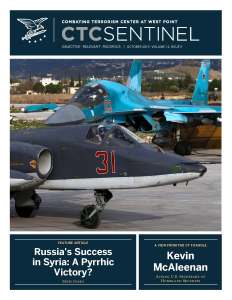From the Editor
In our cover article, Seth Jones examines the Russian military campaign in Syria. He writes: “Russia has done what many thought was impossible in Syria. It has helped Syrian President Bashar al-Assad reconquer most of the country’s major cities and nearly two-thirds of its population. Moscow adopted a military approach that combined well-directed fires and ground maneuver to overwhelm a divided enemy. But it also used extraordinary violence against civilians and provided diplomatic cover when Syrian forces used chemical weapons. Moving forward, Russia faces considerable challenges ahead. Syria is a fractured country with an unpopular regime and massive economic problems; terrorist groups like the Islamic State and al-Qa`ida persist; and Israel and Iran remain locked in a proxy war in Syria.”
Our interview is with Acting Secretary of Homeland Security Kevin McAleenan. He discusses DHS’ recently published new Strategic Framework for Countering Terrorism and Targeted Violence and how DHS is intensifying efforts to counter the threat of far-right terror.
Daniel Milton, Julia Lodoen, Ryan O’Farrell, and Seth Loertscher examine a recently declassified collection of 27 personnel records for Islamic State fighters, both local and foreign. The forms were acquired by the Department of Defence in Syria in 2016 and are now available to view on the Combating Terrorism Center’s website. According to Milton and his co-authors, the forms “demonstrate how extensive the breadth of information collected was in some cases … [and] show that the Islamic State acquired information useful for understanding the radicalization process, encouraging accountability among its fighters, managing the talent in the organization, and vetting members for potential security concerns.”
Damien Spleeters outlines how his organization Conflict Armament Research helped prosecutors secure a guilty plea in the prosecution of Haisem Zahab, an Australian extremist with contacts into the Islamic State and whose research in Australia into rockets “indicates [according to the prosecution] significant commonality” with the Islamic State’s weapon production program in Iraq and Syria.
Michael Shkolnik and Alexander Corbeil examine how Hezbollah “virtual entrepreneurs” have in recent years used social media to recruit Israeli Arabs and West Bank-based Palestinians to attack Israelis.
Paul Cruickshank, Editor in Chief
 Skip to content
Skip to content

